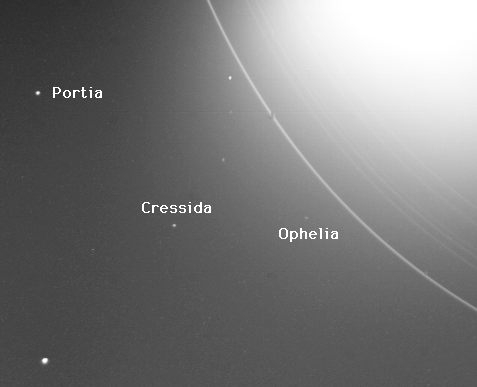September 6, 2017 report
Study of Uranus suggests some of its moons are on a collision course

(Phys.org)—A trio of researchers, two with the University of Idaho, the other with Wellesley College, has found evidence suggesting that two pairs of Uranus's moons are on a collision course. Robert Chancia, Matthew Hedman and Richard French have uploaded a paper describing their observations to the arXiv preprint server.
Uranus is the seventh planet from the sun and the third largest. Prior research has suggested that it is, like Neptune, an ice giant (as compared to gas giants). It has also been found to have the chilliest atmosphere among all the planets in the solar system. And it has both a ring system and multiple satellites—27 in all. The satellites orbiting the planet are believed to be very low mass compared to the moons of the other planets, and some of them, according to this latest research, are on a collision course that will shatter them into small bits.
The researchers report that they were studying the planet's rings, which are collectively called Eta, and discovered that they had an oddly shaped orbit—not round or even circular. Instead, they describe it as sort of triangular. More study showed that the odd orbit of the rings was due to gravitational pull from Cressida—one of the planet's moons. The gravitational impact is exaggerated, they note, due to the moon keeping pace with the orbit of the planet. The particles in the ring, on the other hand, move faster than the moon. This results in the moon tugging on the ring at as it passes by, causing the odd orbital shape. The tug exerted by the moon on the rings allowed the team to deduce its mass. They found that it is around 1/300,000th that of our own moon. Also, it has only 86 percent of the density of water, which indicates it is porous.
In studying the orbits of the moons, the researchers found that Cressida is on a path that will cause it to collide with another moon called Desdemona, which currently moves in an orbit just 900 kilometers from Cressida's. The gravity of Cressida is slowly pulling them closer together and will cause them to crash into one another in approximately 1 million years. They also found the same to be true for Cupid and Belinda, which will collide sometime later.
The researchers note that material in the inner rings around Uranus appears likely to be the remnants of other moons that were destroyed when they collided.
More information: Weighing Uranus' moon Cressida with the η ring, arXiv:1708.07566 [astro-ph.EP] arxiv.org/abs/1708.07566
Abstract
The η ring is one of the narrow rings of Uranus, consisting of a dense core that is 1-2 km wide and a diffuse outer sheet spanning about 40 km. Its dense core lies just exterior to the 3:2 Inner Lindblad Resonance of the small moon Cressida. We fit the η ring radius residuals and longitudes from a complete set of both ground-based and Voyager stellar and radio occultations of the Uranian rings spanning 1977-2002. We find variations in the radial position of the η ring that are likely generated by this resonance, and take the form of a 3-lobed structure rotating at an angular rate equal to the mean motion of the moon Cressida. The amplitude of these radial oscillations is 0.667±0.113 km, which is consistent with the expected shape due to the perturbations from Cressida. The magnitude of these variations provides the first measurement of the mass and density of the moon Cressida (m=2.5±0.4×1017 kg and ρ=0.86±0.16 g/cm3) or, indeed, any of Uranus' small inner moons. A better grasp of inner Uranian satellite masses will provide another clue to the composition, dynamical stability, and history of Uranus' tightly packed system of small moons.
Journal information: arXiv
© 2017 Phys.org





















